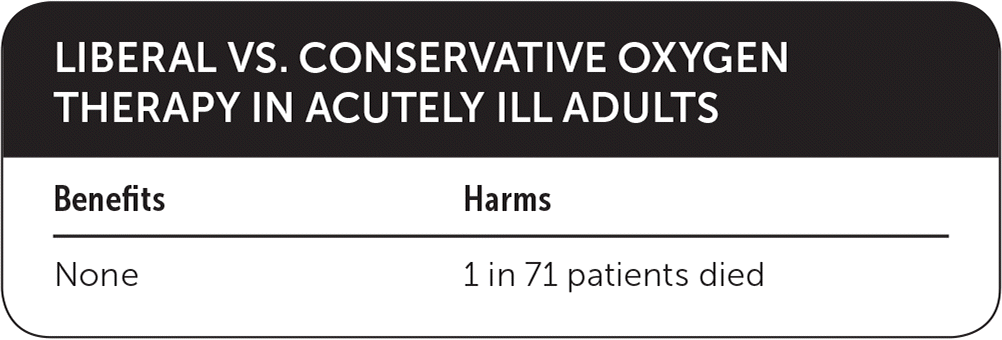
Am Fam Physician. 2019;99(1):online
Author disclosure: No relevant financial affiliations.


| Benefits | Harms |
|---|---|
| None | 1 in 71 patients died |
Details for This Review
Study Population: Acutely ill adults, without chronic respiratory illness, requiring hospital admission and with the potential to be exposed to supplemental oxygen
Efficacy End Points: Mortality (in-hospital, 30-day, and longest follow-up) and morbidity (disability at longest follow-up, risk of hospital-acquired pneumonia, any hospital-acquired infection, and length of hospital stay)
Harm End Points: Morbidity and mortality
Narrative: Oxygen has been used to treat acute illness since the late 1800s.1 Often, treatment with oxygen results in the patient becoming hyperoxemic.2 Many health care professionals view supplemental oxygen as harmless, even in the setting of hyperoxemia.3 However, hyperoxemia can have deleterious effects on the cardiovascular, pulmonary, central nervous, and immune systems. Most of its adverse effects are thought to be secondary to reactive oxygen species causing cell death and hyperoxia-induced vasoconstriction.4
In this article, we summarize the Improving Oxygen Therapy in Acute-Illness systematic review and meta-analysis comparing liberal vs. conservative oxygen therapy in adults who are acutely ill.5 The systematic review included 25 randomized controlled trials involving 16,037 patients with the following conditions: sepsis, critical illness, stroke, trauma, myocardial infarction, and cardiac arrest. Oxygen saturation was reported as fraction of inspired oxygen (FiO2), arterial partial pressure of oxygen, arterial oxygen saturation, and peripheral oxygen saturation (SpO2). Studies were excluded if they involved patients who were younger than 18 years, pregnant, had psychiatric disease, were on extracorporeal life support, used hyperbaric oxygen, underwent elective surgery, or included only patients with chronic obstructive pulmonary disease.
In the liberal oxygen group, the median FiO2 was 0.52 (which would be achieved with 8 L via face mask) for a median duration of eight hours. The conservative supplementation group had a median FiO2 of 0.21 (the same as room air). Oxygen was delivered via nasal cannula in four trials, face mask in 13 trials, and invasive mechanical ventilation in eight trials. The median pretreatment SpO2 was 96.4% in the liberal group and 96.7% in the conservative group.
Liberal oxygen use was found to increase mortality. Liberal oxygen use increased the absolute risk of mortality in-hospital by 1.1% (95% confidence interval [CI], 0.2 to 2.2), at 30-days by 1.4% (95% CI, 0.1 to 2.7), and at longest-follow-up by 1.2% (95% CI, 0 to 2.4) for a number needed to harm of 91, 71, and 83, respectively. There were no significant interactions identified on subgroup analysis, including intensive care unit vs. nonintensive care, delivery method, and duration of oxygen exposure.
There was no difference in the overall risk of hospital-acquired infections between the two groups. In the subgroup of patients who had emergency surgery (two trials, 449 patients), there were fewer hospital-acquired infections in the liberal oxygen group (relative risk = 0.50; 95% CI, 0.36 to 0.69). This was not noted in patients admitted with a medical diagnosis. Both trials in emergency surgery were at high risk of bias. There was no difference between the two groups in risk of hospital-acquired pneumonia or length of stay.
Caveats: The meta-analysis did not include adults with chronic respiratory illnesses, which may have a different physiologic response to hyperoxemia. The various studies included in this analysis had differing definitions of liberal and conservative oxygenation, which may lead to an imprecise estimation of mortality. Some studies had a fixed FiO2, whereas others titrated up to a target oxygen level. Longest follow-up varied widely among the studies. Most studies did not report cause-specific mortality; therefore, the mechanism of harm of hyperoxia could not be identified. Some of the trials included were stopped early because of apparent benefit or harm.
It should be noted that the Thoracic Society of Australia and New Zealand guidelines recommend a target oxygen saturation range of 92% to 96% for oxygen therapy in adults without chronic respiratory failure.6
Copyright © 2019 MD Aware, LLC (theNNT.com). Used with permission.
This series is coordinated by Dean A. Seehusen, MD, MPH, AFP Assistant Medical Editor, and Daniel Runde, MD, from the NNT Group.
A collection of Medicine by the Numbers published in AFP is available at https://www.aafp.org/afp/mbtn.
